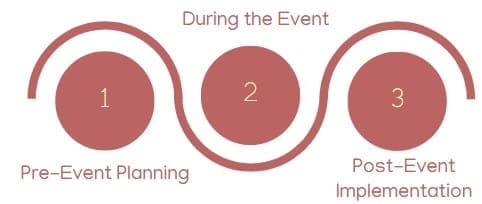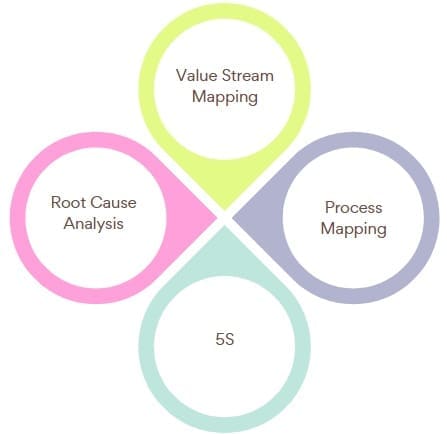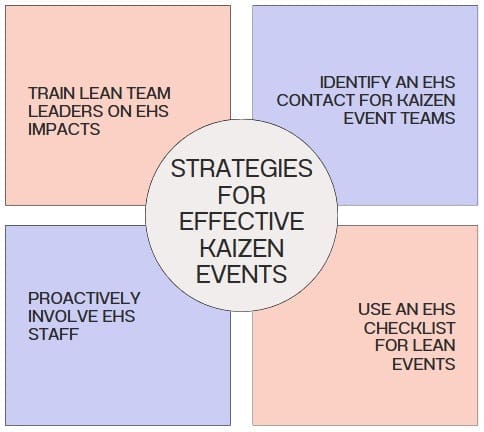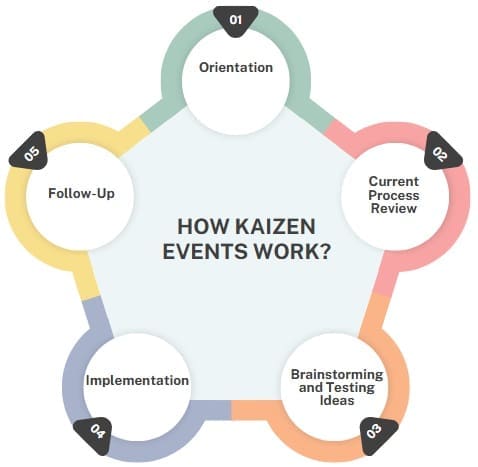A Kaizen event is a focused, short-term improvement initiative used in Lean methodology to enhance business processes. It aims to identify inefficiencies and eliminate waste, improving overall productivity and service quality. The word “Kaizen” is Japanese, meaning “change for the better.”
During a Kaizen event, teams come together to analyze a process, find areas for improvement, and implement changes. This process can last 3-5 days and focuses on actionable results that lead to real change.
A Kaizen event targets eliminating waste and inefficiencies in processes to boost productivity, reduce costs, and improve quality. These events usually take place over 2-7 days, but planning can take much longer.
Table of contents
What is a Kaizen Event?
A Kaizen Event is a focused, short-term effort designed to implement rapid improvements in a process. It typically lasts two to five days and is a part of the broader Kaizen philosophy. Toyota developed this philosophy and focuses on continuous improvement within organizations.
The term “Kaizen” comes from two Japanese words, “Kai” meaning change and “Zen” meaning good, thus it refers to “change for the better.”
Kaizen events are also called rapid process improvement events or Kaizen blitzes. The goal of these events is to make significant changes in a short amount of time. The focus is on improving processes by eliminating waste, cutting costs, and enhancing quality. Kaizen events are part of Lean methodology, which aims to make processes more efficient.
These events are typically scheduled to last between 2 to 7 days. However, much of the groundwork, such as data gathering and team preparation, happens long before the actual event. Participants work together in a focused environment to analyze processes, brainstorm solutions, and implement changes quickly.
Origin of Kaizen
The Kaizen philosophy originated in Japan and was heavily influenced by Toyota’s production methods. Taiichi Ohno, a Toyota executive, studied mass production techniques, drawing inspiration from Henry Ford and U.S. grocery store operations. He also incorporated guidance from W. Edwards Deming, a quality control expert.
Originally applied in manufacturing, industries including healthcare and service sectors have since embraced Kaizen principles.
Purpose of a Kaizen Event
A Kaizen Event aims to identify waste and inefficiency in a process and implement solutions that lead to measurable improvements. Unlike large-scale improvement projects that require significant time and investment, Kaizen Events focuses on quick, effective change.
These events leverage the combined input of a small, cross-functional team and focus on improving specific areas that have a measurable impact on performance.
Waste can be in the form of time, materials, energy, or unnecessary steps that do not add value to the customer. By removing these wastes, businesses can improve efficiency, reduce costs, and increase profitability.
Besides eliminating waste, Kaizen events are also focused on improving working conditions. For example, employees may find that a Kaizen event helps streamline their work processes, making their jobs easier and safer.
Kaizen events also provide a valuable opportunity for companies to meet environmental, health, and safety (EHS) goals. Reducing waste, saving energy, and preventing pollution are all important benefits of Kaizen events.
Phases of a Kaizen Event

- Pre-Event Planning: Before the Kaizen event begins, teams meet to plan and gather data. This step ensures everyone is prepared and understands the goals and scope of the event.
- During the Event: The event typically lasts 3-5 days. Participants work together to identify process inefficiencies, brainstorm solutions, and create a detailed implementation plan.
- Post-Event Implementation: After the event, the team works to implement the changes identified during the event. Regular follow-up meetings are scheduled to track progress and make adjustments as needed.
Key Participants in a Kaizen Event

A typical Kaizen team consists of 5 to 10 members with a facilitator guiding the process. The team should include:
- Team Leader: Responsible for guiding the team and overseeing the event.
- Process Experts: 1-4 individuals who know the process being analyzed.
- Support Members: 1-2 members with related expertise, such as IT or budgeting.
- External Members: 1-2 individuals from outside the team who bring new perspectives or Lean experience.
- Guests: Customers or stakeholders who can provide feedback on the process and help identify areas for improvement.
Kaizen Tools and Techniques

During a Kaizen event, various Lean tools are used to analyze and improve processes. Some of the tools include:
Value Stream Mapping: A technique used to visualize the flow of information and materials within a process. It helps identify inefficiencies and improvement opportunities.
Process Mapping: This tool helps break down complex processes into smaller, manageable steps to identify areas for improvement.
5S: A method to improve workplace organization, increase efficiency, and reduce waste by focusing on sorting, setting in order, shining, standardizing, and sustaining.
Root Cause Analysis: Teams identify the underlying causes of problems rather than just addressing symptoms.
Why Are Kaizen Events Important?
Kaizen events are crucial for organizations that are committed to continuous improvement. These events create a structured environment where teams can focus on identifying problems and implementing solutions. The benefits include:
Eliminating Non-Value-Added Activities: By analyzing processes, teams can find steps that don’t contribute to the final product or service and eliminate them.
Reducing Waste: This includes energy waste, water usage, scrap materials, pollution, and hazardous waste. Eliminating these inefficiencies can lead to significant cost savings.
Improving Working Conditions: Kaizen events can enhance the overall work environment by reducing repetitive tasks, cutting down on mistakes, and ensuring a safer, more efficient workspace.
Environmental Impact: Reducing pollution, scrap, and other waste contributes to meeting environmental goals and regulatory compliance.
Key Considerations for Successful Kaizen Events
To ensure Kaizen events are successful, it’s important to carefully manage several aspects of the event, including:
- EHS (Environmental, Health, and Safety) Expertise: If not properly managed, Kaizen events can inadvertently lead to compliance violations or unsafe working conditions. EHS experts should be involved in the planning and execution of Kaizen events.
- Regulatory Compliance: Ensuring that the changes made during a Kaizen event do not violate environmental or safety regulations is critical.
- Health and Safety: The team must assess risks and ensure the changes made improve, rather than harm, worker safety.
Strategies for Effective Kaizen Events

To maximize the effectiveness of Kaizen events, organizations can implement several strategies:
- Train Lean Team Leaders on EHS Impacts: Training helps team leaders identify potential EHS concerns. They should be familiar with changes that require EHS input and know how to spot opportunities for environmental improvements.
- Identify an EHS Contact for Kaizen Event Teams: Having a dedicated EHS contact ensures quick responses to any environmental, health, or safety issues that may arise during the event.
- Use an EHS Checklist for Lean Events: A checklist ensures that teams do not overlook critical EHS considerations during the event.
- Proactively Involve EHS Staff: Engaging EHS staff early in the process helps avoid problems and ensures that environmental goals are met.
Kaizen Event Roles and Responsibilities
In a Kaizen event, several roles are essential for its success:
- Kaizen Team Leader: The leader coordinates the event, ensures all tasks are completed, and supports the team. They work closely with the team to define the project scope and gather necessary data before the event.
- Kaizen Team Members: The team members actively participate in process analysis and contribute ideas for improvement. They bring knowledge of the processes being analyzed.
- EHS Experts: EHS professionals guide the team in managing environmental and safety concerns. They ensure compliance with regulations and identify opportunities for waste reduction.
- Facilitator: A trained facilitator ensures that the event runs smoothly, challenges the team to think creatively, and helps guide the process.
- Management: Managers play a key role by supporting the team, encouraging collaboration, and providing necessary resources for the event. They should also monitor the implementation of improvements after the event.
Benefits of Kaizen Events
Kaizen events provide several benefits, including:
- Increased Efficiency: Organizations can operate more efficiently by eliminating waste and optimizing processes.
- Improved Quality: Kaizen events focus on enhancing the quality of work by addressing root causes of defects and inefficiencies.
- Employee Engagement: Kaizen encourages participation from employees at all levels, empowering them to take part in process improvements.
- Customer Satisfaction: Improved processes lead to better products and services, resulting in higher customer satisfaction.
- Sustained Improvement: Kaizen fosters a culture of continuous improvement that drives long-term success.
- Faster throughput: Improved speed of operations.
- Freed capacity: Maximized use of available resources.
- Workforce satisfaction: Employee engagement and satisfaction increase when their input is valued.
- Cost reduction: Decreased costs, particularly in non-labor-intensive areas.
- Increased revenue: Improved cash flow due to streamlined operations.
How Kaizen Events Work?

A focused team structures a Kaizen Event and works together over several days. A trained facilitator usually leads the event and includes employees from various functions to ensure they consider all aspects of the process. The steps typically followed during a Kaizen Event include:
- Orientation: Team members are introduced, and the goals of the event are outlined.
- Current Process Review: The team analyzes the existing process to identify inefficiencies.
- Brainstorming and Testing Ideas: Ideas for improvements are discussed and tested.
- Implementation: The best solutions are implemented quickly.
- Follow-Up: Results are monitored, and any unresolved issues are addressed.
Kaizen Event Structure
Kaizen Events are typically broken down into three phases:
Planning and Preparation: During this phase, the team collects background data, selects the target process, and assembles the team. They make necessary preparations to ensure a successful event.
Implementation: The event takes place over two to five days, during which the team works intensively to make improvements. During this phase, the team maps the process, collects data, brainstorms, and implements solutions.
Follow-Up: After the event, document the improvements and communicate the results. Monitor ongoing progress to ensure the changes are sustained.
Post-Kaizen Event
After the event concludes, ensure the team implements and sustains the changes. The Kaizen event team will create an actionable plan outlining the changes they will make, along with short-term and long-term goals. The team should also meet regularly to review progress and adjust the plan as necessary.
Final Words
Kaizen Events offers an efficient and cost-effective way for organizations to improve their processes and performance. By focusing on small, rapid improvements, Kaizen Events can deliver significant results. Successful implementation depends on leadership support, employee involvement, clear goals, and follow-up.
With the right planning and execution, Kaizen Events can lead to dramatic improvements in quality, efficiency, and employee satisfaction.

About Six Sigma Development Solutions, Inc.
Six Sigma Development Solutions, Inc. offers onsite, public, and virtual Lean Six Sigma certification training. We are an Accredited Training Organization by the IASSC (International Association of Six Sigma Certification). We offer Lean Six Sigma Green Belt, Black Belt, and Yellow Belt, as well as LEAN certifications.
Book a Call and Let us know how we can help meet your training needs.



















